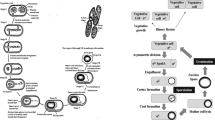Abstract
Enterococcus faecalis is a Gram-positive bacteria, considered one of the most common causes of nosocomial infections. Bacterial cultures produce an exchange of energy as a result of the bacteria metabolisms. The rate of heat production is an adequate measure of the metabolic activity of the organisms and their constituent parts. Microorganisms produce small amounts of heat: 1–3 pW per cell. Although the heat produced by bacteria is very small, their exponential reproduction in a culture medium permits heat detection through microcalorimetry. In this study, we analyzed the microcalorimetric behavior of Enterococcus faecalis. A thermal Calvet microcalorimeter was used. The inside of the calorimeter contains two stainless steel cells (experimental and reference). Experiments were carried out at final concentrations of 106,105,103, and 10 CFU/mL and a constant temperature of 309.65 K was maintained within the microcalorimeter. Recording the difference in calorific potential over time we obtained E. faecalis’s growth curves. Thermograms were analyzed mathematically allowing us to calculate the constant growth, generation time and the amount of heat exchanged over the culture time.



Similar content being viewed by others
References
Murray P, Rosenthal K, Pfaller M. Microbiología médica. España: Elsevier Mosby; 2009.
Kenneth J, Ryan C, George R. Microbiología médica. Una introducción a las enfermedades infecciosas. Madrid: McGraw Hill; 2004.
Calvet E, Prat H. Microcalorimétrie: aplications physico-chimiques et biologiques. Paris: Masson el Cie Editeurs; 1956.
Ma J, Qi WT, Yang LN, Yu WT, Xie YB, Wang W. Microcalorimetric study on the growth and metabolism of microencapsulated microbial cell culture. J Microbiol Methods. 2007;68:172–7.
James AM. Calorimetry. Past, present and future. In: Thermal and energetic studies of cellular biological systems. Bristol: IOP Publishing Ltd; 1987
Trampuz A, Salzmann S, Antheaume J, Daniela AU. Microcalorimetry: a novel method for detection of microbial contamination in platelet products. Transfusion. 2007;47:1643–50.
Lago N, Legido JL, Arias I, García F. Aplicaciones de la microcalorimetría como método de identificación precoz del crecimiento bacteriano. Invest Cult Cienc Tecnol. 2010;2(3):6–9.
Lago N, Legido JL, Paz-Andrade MI, Arias I, Casás LM. Microcalorimetric study on the growth and metabolism of Pseudomonas aeruginosa. J Therm Anal Calorim. 2011;105(2):651–5.
Paz Andrade MI. Les Dévelopements Récents de la Microcalorimétrie et de la Thermogenese. 1st ed. Paris: CRNS; 1967.
O`Neill M, Vine G, Beezer A, Bishop A, Hadgraft J, Labetoulle Ch. Antimicrobial properties of silver-containing wound dressings: a microcalorimetric study. Int J Pharm. 2003;263:61–8.
Wang X, Liu Y, Xie B, Shi X, Zhou J, Zhang H. Effects of nisin on the growth of Staphylococcus aureus determined by a microcalorimetric method. Mol Nutr Food Res. 2005;49:350–4.
Liang H, Wu J, Liu Y, Yang L, Hu L, Qu S. Kinetics of the action of three selenides on Staphylococcus aureus growth as studied by microcalorimetry. Biol Trace Elem Res. 2003;92:181–7.
Yang LN, Xian L, Xu F, Zhang J, Zhao JN, Zhao ZB. Inhibitory study of two cephalosporins on E. coli by microcalorimetry. J Therm Anal Calorim. 2010;100:589–92.
Xu XJ, Chen C, Wang Z, Zhang Y, Hou A, Li C. Antibacterial activities of novel diselenide-bridged bis(Porphyrin)s on Staphylococcus aureus investigated by microcalorimetry. Biol Trace Elem Res. 2008;125:185–92.
Yan D, Hna YM, Wei L, Xiao XH. Effect of berberine alkaloids on Bifidobacterium adolescentis growth by microcalorimetry. J Therm Anal Calorim. 2009;95(2):495–9.
Kong W, Li Z, Xiao X, Zhao Y, Zhang P. Activity of barberine on Shigella dysenteriae investigated by microcalorimetry and multivariate analysis. J Therm Anal Calorim. 2010;102:331–6.
Baldoni D, Hermann H, Frei R, Trampuz A, Steinhuber A. Performance of microcalorimetry for early detection of methicillin resistance in clinical isolates of Staphylococcus aureus. J Clin Microbiol. 2009;47(3):774–6.
Acknowledgements
We thank María Perfecta Salgado González and Sofia Baz Rodríguez for their collaboration with the technical measures.
Author information
Authors and Affiliations
Corresponding author
Rights and permissions
About this article
Cite this article
Rivero, N.L., Legido Soto, J.L., Casás, L.M. et al. Microcalorimetric study of the growth of Enterococcus faecalis in an enriched culture medium. J Therm Anal Calorim 108, 665–670 (2012). https://doi.org/10.1007/s10973-011-2052-1
Published:
Issue Date:
DOI: https://doi.org/10.1007/s10973-011-2052-1




